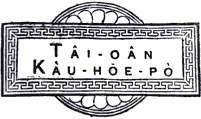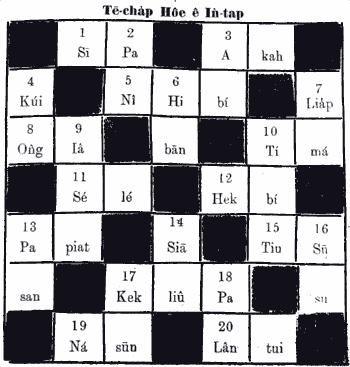Several stories have come out in the past couple of weeks on the Santa (or Sarta), reportedly the least literate of China’s 56 official “national minorities.” They’re more often referred to as the “Dongxiang,” a Mandarin name that has been applied to them by the Han.
The stories are interesting in themselves. But I was struck most by an odd detail:
In grammar school, the curriculum is in Chinese and many kids drop out. Government statistics show that the average person in Dongxiang has only 1.1 years of schooling. Because of the cost, many families never even send children to school, particularly daughters….
The challenge of trying to teach Chinese to Dongxiang children has attracted international aid groups to Dongxiang. The British government is funding a large training program for teachers.
Another pilot program, funded by the U.S.-based Ford Foundation, has created a bilingual curriculum using a Dongxiang-Chinese dictionary developed by Chen and other scholars. That program has already produced a jump in test scores but is currently in search of more funding.
British and American groups go to China to help teach Mandarin to people there? That can’t be right, can it?
I looked on the Ford Foundation’s Web site. The foundation’s unit on education, sexuality, and religion (?!) gave a US$30,000 grant in 2004 “for a pilot project using bilingual education in Dongxiang language and standard Chinese to reduce school drop-out rates.” So I think what’s happening is that the Western groups are helping expand education in Santa rather than in Mandarin, at least for a few years, since the latter language is what teachers had been teaching in.
For years, many Chinese scholars assumed the Dongxiang descended from the Mongol soldiers in Genghis Khan’s army who eventually settled in Gansu during the 13th century, when the Mongols ruled China under the Yuan dynasty. But their exact origins were never fully known, an uncertainty that fed an inferiority complex.
“A man once asked me, ‘Where do the Dongxiang come from?'” said Ma Zhiyong, a historian who grew up in the county but moved to the provincial capital, Lanzhou, as a teenager. “I was 18 or 19 and couldn’t answer the question. I was ashamed.”
Ma decided to look for an answer. Over several years, he scoured research libraries in Gansu, talked to other scholars and studied old maps. He found that some Dongxiang villages shared names with places in Central Asian countries like Uzbekistan. He also found shared customs: He said peasants in Uzbekistan and Dongxiang both learn to cut a slaughtered chicken into 13 pieces. And he observed that Dongxiang people described themselves as “sarta” — a term that once referred to Muslim traders in Central Asia.
He concluded that the story about Khan’s army was only half right. Some of the Dongxiang ancestors were Mongol soldiers. But many others were a diverse group of Middle Eastern and Central Asian craftsmen conscripted into the Mongol army during Khan’s famed western campaign. They brought several languages and many brought a strong belief in Islam. Ma concluded that generations of intermarriage, including with local Han Chinese and Tibetans, resulted in a new ethnic group and language.
The language, if a source of pride, is also blamed for Dongxiang’s educational shortcomings. The language is oral, so children never learn to read or write in their native tongue.
Hundreds of millions of people in China never learn to read or write in their native tongue. Instead, the Han Chinese are told they’re speaking merely a “dialect” and so must learn to read and write Mandarin. And everybody else is supposed to learn to read and write Mandarin, too.
Here’s part of the section on Santa from Robert Ramsey’s ever-useful The Languages of China:
The Santa language resembles its relative Dagur in many respects. It has preserved the initial h‘s of Middle Mongolian: hulan ‘red.’ (But long vowels have become short, as the originally long a in the second syllable of this word has done.) And, like Dagur, Santa has progressed noticeably toward an “open syllable” kind of structure — but by a slightly different process. Many consonants that once closed syllables, including r, have been lost in Santa. For example, Middle Mongolian bulag ‘spring’ has become bula; marghasi ‘tomorrow’ has become magashi. The consonants -l and -m have changed to -n. The result of these changes is that n is now the only consonant that closes syllables. In Santa the front vowels ö and ü have changed in pronunciation and are now not distinguished from o and u. Vowel harmony has been lost in the language. In Santa syntax, the genitive and the accusative are marked with the same particle.
More than likely, many of the changes that have taken place in Santa can be attributed to the centuries of contact that the speakers of this language have had with northern Chinese groups. The tendency toward an open syllable is typical of the Mandarin dialects, as is the change of final -m to -n. One particularly striking adaption to Chinese is the hybrid construction made in Santa using the Chinese copula shi ‘is.’ This copula is put into the sentence in Chinese syntactic order, between the nouns being equated; but the old Mongolian copula is also kept, appearing in its usual position at the end of the sentence. The result is a strange double-copula construction that is neither Chinese nor quite Mongolian. Here are two examples (the Chinese copula is given in small capitals):
| Ene |
ki̵wan |
shi |
kienni |
we. |
| this |
youth |
is |
whose |
is |
| ‘Whose boy is this?’ |
| Bi |
kieliesen |
kun |
shi |
ene |
we. |
| I |
spoke |
person |
is |
this |
is |
| ‘The person I was talking about is this one.’ |
Around 30 percent of the Santa vocabulary is reported to be borrowed from Chinese.
For more examples, see the final link below:
sources:
- Poor, illiterate and unaware they’re in China, International Herald Tribune, March 7, 2006
- Deep in China, a Poor and Pious Muslim Enclave (same article as the above), New York Times, March 19, 2006
- 民族教育新鲜事–东乡族双语教学实验调查, Gansu Ribao, March 9, 2006
- “Ethnicity, Language, and School Success in China” and “Research on the Language Factor: The Influence on Learning for Dongxiang Ethnic Minority Students,” China Education Forum, September 2003 (PDF)
- grant information: Narisi Primary School of Dongxiang Autonomous County, Ford Foundation
- Gansu Basic Education Project
- The Dongxiang Mongols and Their Language





